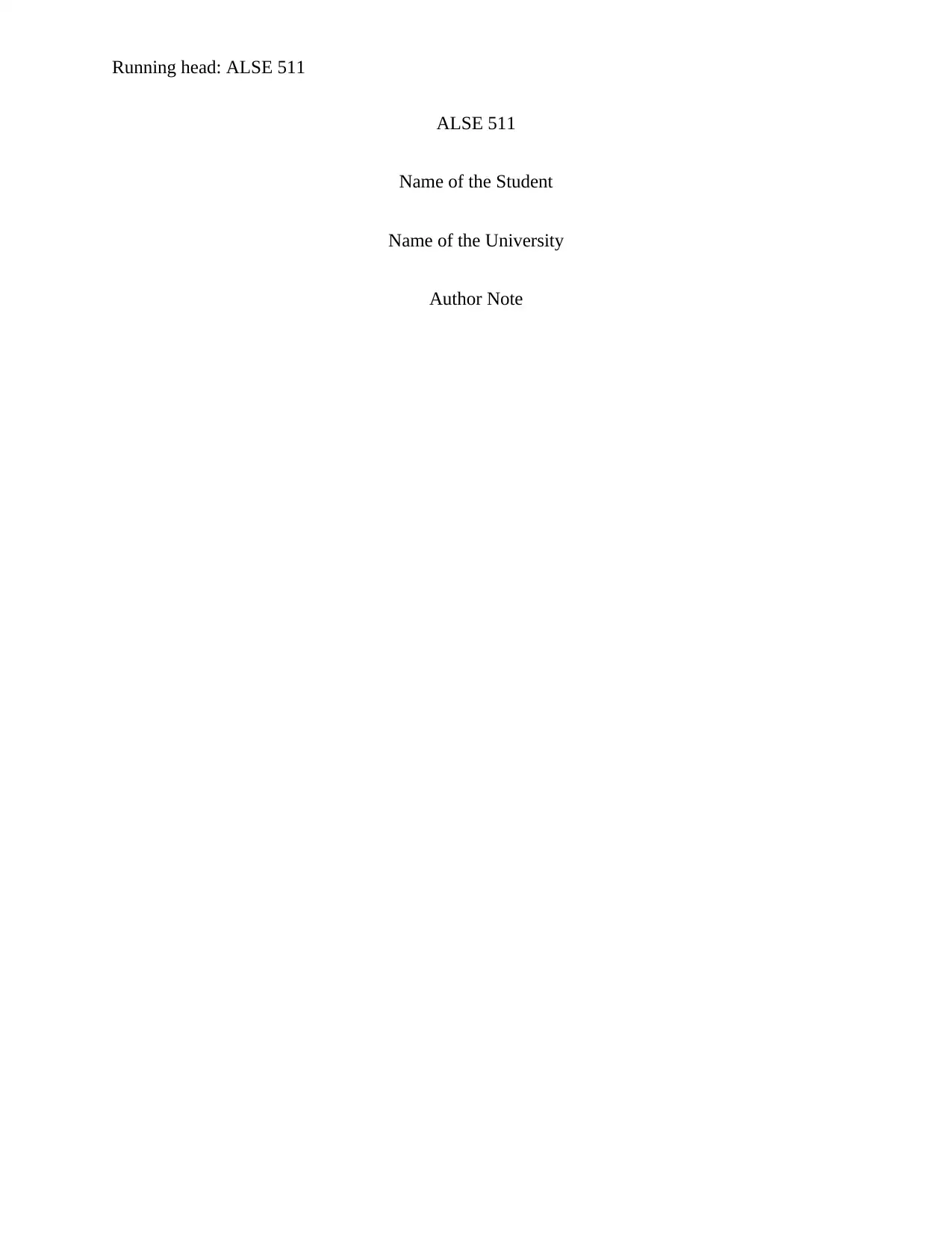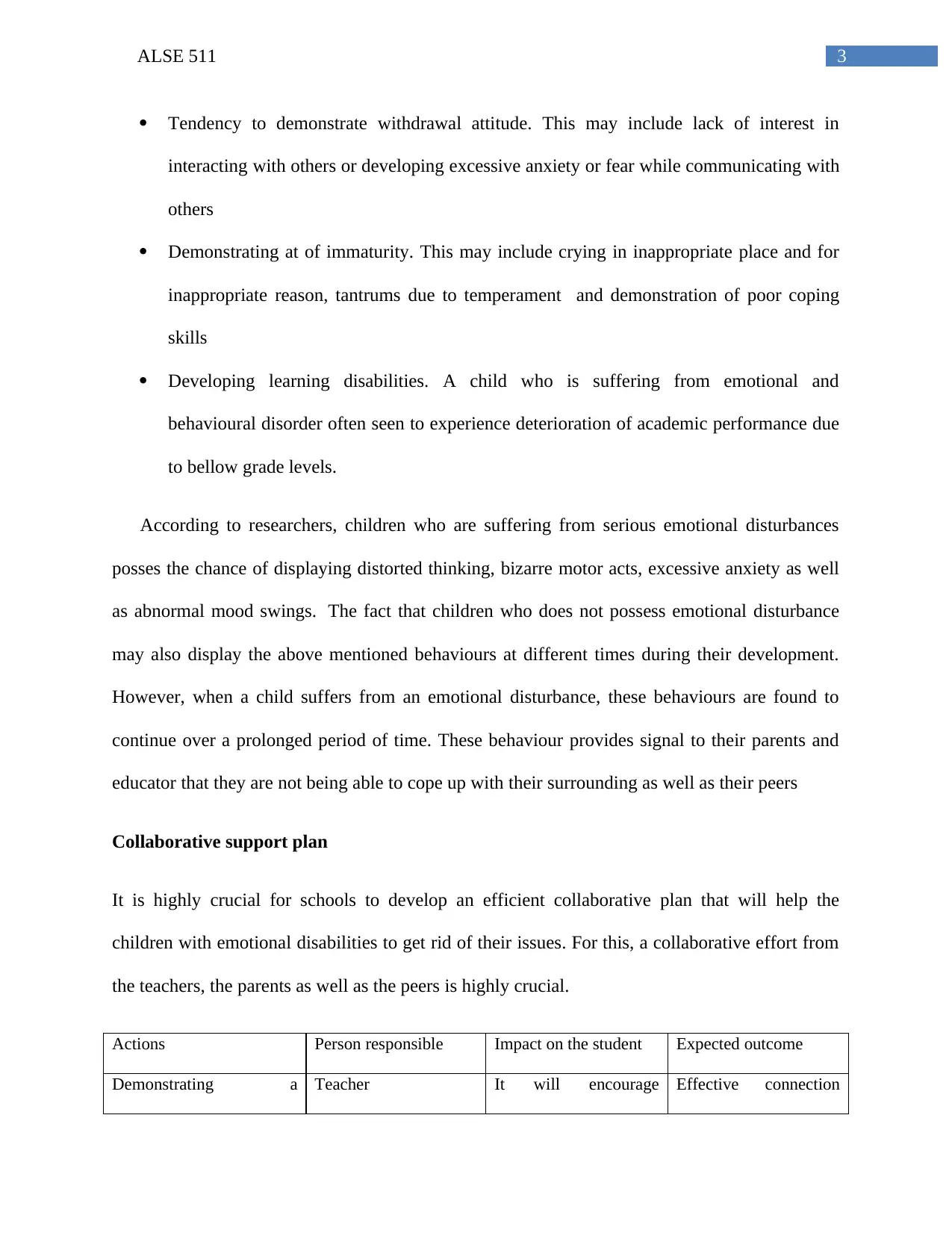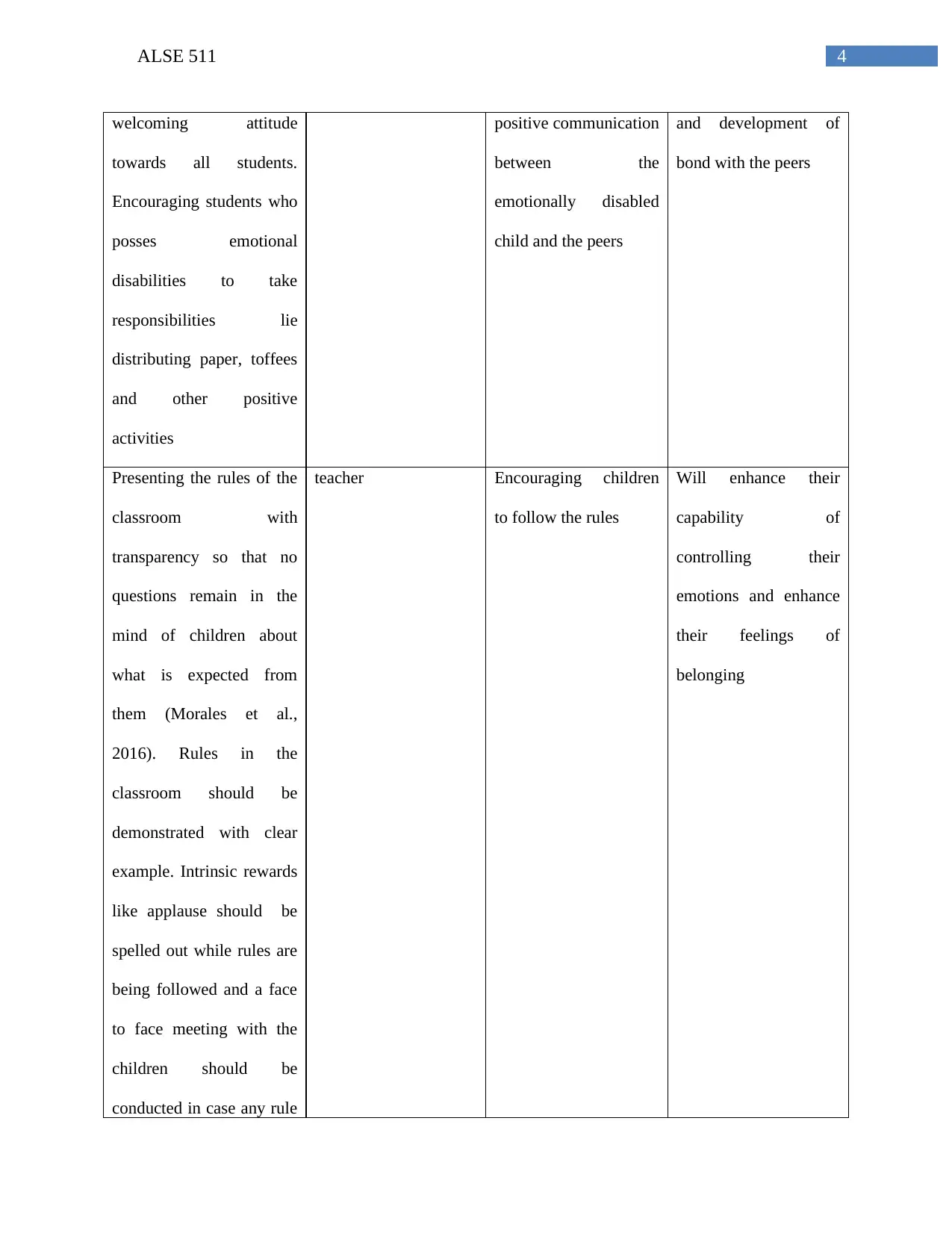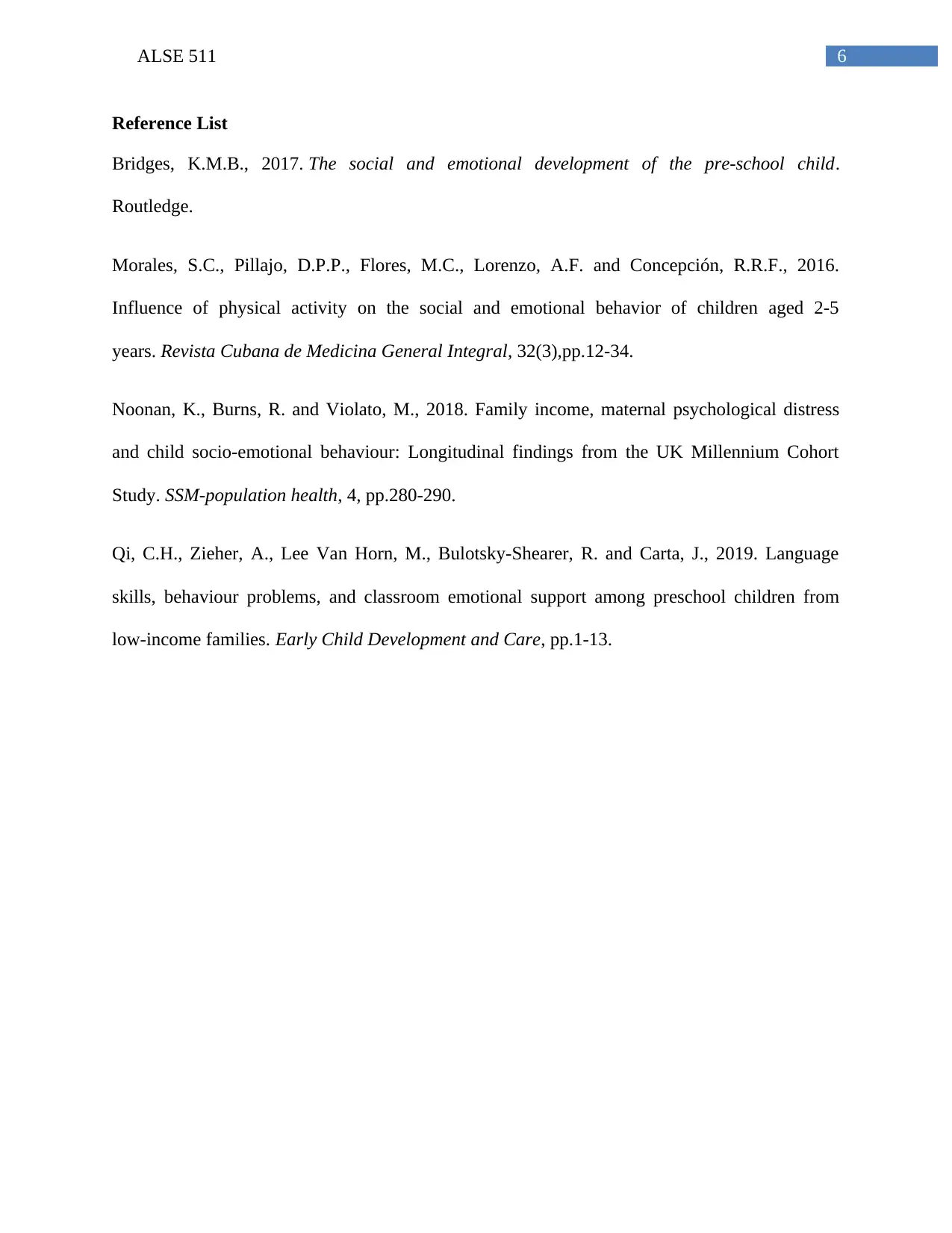ALSE 511: Analysis of an Emotionally and Behaviourally Disturbed Child
VerifiedAdded on 2022/09/18
|7
|1247
|24
Essay
AI Summary
This essay, prepared for ALSE 511, examines the concept of emotionally and behaviourally disturbed children. It begins by defining the term and explores the characteristics identified by Bower, aligning with American legislation. The discussion then delves into the intertwined nature of emotional and behavioural deviations, highlighting how emotional disturbances affect physical, social, and cognitive skills. The essay outlines major emotional and behavioural deviations, including hyperactivity, aggression, withdrawal, immaturity, and learning disabilities. It emphasizes that these behaviours, while sometimes present in all children, persist over a prolonged period in disturbed children. The essay proposes a collaborative support plan involving teachers, parents, and peers to address these issues, detailing specific actions and expected outcomes for each stakeholder. The conclusion underscores the importance of early intervention and support from educators and parents to mitigate the psychological and behavioural challenges faced by these children. References from Bridges (2017), Morales et al. (2016), Noonan, Burns, and Violato (2018), and Qi et al. (2019) are included.

Running head: ALSE 511
ALSE 511
Name of the Student
Name of the University
Author Note
ALSE 511
Name of the Student
Name of the University
Author Note
Paraphrase This Document
Need a fresh take? Get an instant paraphrase of this document with our AI Paraphraser

1ALSE 511
Emotionally and behaviourally disturbed child
Introduction
The term emotional and behavioural disturbance referred to a classification of disability
that is used in educational settings. This classification allows educational institutions for
providing special education as well as associated services to the students who display both
academic and social progress. In the following paragraph, the emotional disorder of a child will
be defined and analysed. Along with this a collaboration support plan in order to help the child to
recover from the disorder will also be provided in the following paragraph.
Discussion
Definition of the emotional/Behavioural child
According to Bridges (2017), an emotionally or behaviourally disturbed child’s definition
cannot be specified due to the explanations that sought from various scientific angles. However,
as per researchers, a certain number of characteristics are common to the children since that
makes them conspicuous. In this paragraph certain characteristics of an emotionally or
behaviourally disturbed child that has been identified by Bower and are also included in the
American Legislation concerning the children with issues has been discussed.
The first characteristic includes inability to learn that cannot be explained on the basis of
intellectual, sensory as well as health factors.
The child develops inability to build as well as maintain satisfactory interpersonal
relationship with the peers as well as the educators
The child conduct abnormal or inappropriate behaviours under normal circumstances
Emotionally and behaviourally disturbed child
Introduction
The term emotional and behavioural disturbance referred to a classification of disability
that is used in educational settings. This classification allows educational institutions for
providing special education as well as associated services to the students who display both
academic and social progress. In the following paragraph, the emotional disorder of a child will
be defined and analysed. Along with this a collaboration support plan in order to help the child to
recover from the disorder will also be provided in the following paragraph.
Discussion
Definition of the emotional/Behavioural child
According to Bridges (2017), an emotionally or behaviourally disturbed child’s definition
cannot be specified due to the explanations that sought from various scientific angles. However,
as per researchers, a certain number of characteristics are common to the children since that
makes them conspicuous. In this paragraph certain characteristics of an emotionally or
behaviourally disturbed child that has been identified by Bower and are also included in the
American Legislation concerning the children with issues has been discussed.
The first characteristic includes inability to learn that cannot be explained on the basis of
intellectual, sensory as well as health factors.
The child develops inability to build as well as maintain satisfactory interpersonal
relationship with the peers as well as the educators
The child conduct abnormal or inappropriate behaviours under normal circumstances

2ALSE 511
The child develops a general sensitive mood of unhappiness or depression
The child demonstrates the tendency to develop fear or physical symptom related to
personal or school issues. It may even include schizophrenia. However, this term is no
applicable for children who have been socially maladjusted, unless their emotional
disturbance has been determined.
Chief emotional and behavioural deviations
According to Noonan, Burns and Violato (2018), emotional life an behaviour of a child is
intertwined inextricably. This it is highly unlikely for a child with emotional disturbance not to
demonstrate any behavioural issues and vice versa. It is highly evident from the above mentioned
definition of a emotionally and behaviourally disturbed child, the emotional disturbance of a
child possess the potential to affect the individual’ area beyond emotion. The child’s physical,
social as well as cognitive skills get affected by his or her emotional disorders. According to Qi
et al. 2019, mental illness can be defined as a medical condition that possess the potential to
disrupt the thinking, feeling, mood along with the ability of the child to relate to daily
functioning. Thus, in a nutshell, emotional disorder, diminish the capability off the child to cope
with ordinary demands of life.
The major emotional and behaviour deviations associated with the emotionally and
behaviourally deviated child include:
Demonstration of hyper activity that includes short attention span and impulsiveness
Demonstration of aggression or even self injurious behaviours like fighting and acting out
The child develops a general sensitive mood of unhappiness or depression
The child demonstrates the tendency to develop fear or physical symptom related to
personal or school issues. It may even include schizophrenia. However, this term is no
applicable for children who have been socially maladjusted, unless their emotional
disturbance has been determined.
Chief emotional and behavioural deviations
According to Noonan, Burns and Violato (2018), emotional life an behaviour of a child is
intertwined inextricably. This it is highly unlikely for a child with emotional disturbance not to
demonstrate any behavioural issues and vice versa. It is highly evident from the above mentioned
definition of a emotionally and behaviourally disturbed child, the emotional disturbance of a
child possess the potential to affect the individual’ area beyond emotion. The child’s physical,
social as well as cognitive skills get affected by his or her emotional disorders. According to Qi
et al. 2019, mental illness can be defined as a medical condition that possess the potential to
disrupt the thinking, feeling, mood along with the ability of the child to relate to daily
functioning. Thus, in a nutshell, emotional disorder, diminish the capability off the child to cope
with ordinary demands of life.
The major emotional and behaviour deviations associated with the emotionally and
behaviourally deviated child include:
Demonstration of hyper activity that includes short attention span and impulsiveness
Demonstration of aggression or even self injurious behaviours like fighting and acting out
⊘ This is a preview!⊘
Do you want full access?
Subscribe today to unlock all pages.

Trusted by 1+ million students worldwide

3ALSE 511
Tendency to demonstrate withdrawal attitude. This may include lack of interest in
interacting with others or developing excessive anxiety or fear while communicating with
others
Demonstrating at of immaturity. This may include crying in inappropriate place and for
inappropriate reason, tantrums due to temperament and demonstration of poor coping
skills
Developing learning disabilities. A child who is suffering from emotional and
behavioural disorder often seen to experience deterioration of academic performance due
to bellow grade levels.
According to researchers, children who are suffering from serious emotional disturbances
posses the chance of displaying distorted thinking, bizarre motor acts, excessive anxiety as well
as abnormal mood swings. The fact that children who does not possess emotional disturbance
may also display the above mentioned behaviours at different times during their development.
However, when a child suffers from an emotional disturbance, these behaviours are found to
continue over a prolonged period of time. These behaviour provides signal to their parents and
educator that they are not being able to cope up with their surrounding as well as their peers
Collaborative support plan
It is highly crucial for schools to develop an efficient collaborative plan that will help the
children with emotional disabilities to get rid of their issues. For this, a collaborative effort from
the teachers, the parents as well as the peers is highly crucial.
Actions Person responsible Impact on the student Expected outcome
Demonstrating a Teacher It will encourage Effective connection
Tendency to demonstrate withdrawal attitude. This may include lack of interest in
interacting with others or developing excessive anxiety or fear while communicating with
others
Demonstrating at of immaturity. This may include crying in inappropriate place and for
inappropriate reason, tantrums due to temperament and demonstration of poor coping
skills
Developing learning disabilities. A child who is suffering from emotional and
behavioural disorder often seen to experience deterioration of academic performance due
to bellow grade levels.
According to researchers, children who are suffering from serious emotional disturbances
posses the chance of displaying distorted thinking, bizarre motor acts, excessive anxiety as well
as abnormal mood swings. The fact that children who does not possess emotional disturbance
may also display the above mentioned behaviours at different times during their development.
However, when a child suffers from an emotional disturbance, these behaviours are found to
continue over a prolonged period of time. These behaviour provides signal to their parents and
educator that they are not being able to cope up with their surrounding as well as their peers
Collaborative support plan
It is highly crucial for schools to develop an efficient collaborative plan that will help the
children with emotional disabilities to get rid of their issues. For this, a collaborative effort from
the teachers, the parents as well as the peers is highly crucial.
Actions Person responsible Impact on the student Expected outcome
Demonstrating a Teacher It will encourage Effective connection
Paraphrase This Document
Need a fresh take? Get an instant paraphrase of this document with our AI Paraphraser

4ALSE 511
welcoming attitude
towards all students.
Encouraging students who
posses emotional
disabilities to take
responsibilities lie
distributing paper, toffees
and other positive
activities
positive communication
between the
emotionally disabled
child and the peers
and development of
bond with the peers
Presenting the rules of the
classroom with
transparency so that no
questions remain in the
mind of children about
what is expected from
them (Morales et al.,
2016). Rules in the
classroom should be
demonstrated with clear
example. Intrinsic rewards
like applause should be
spelled out while rules are
being followed and a face
to face meeting with the
children should be
conducted in case any rule
teacher Encouraging children
to follow the rules
Will enhance their
capability of
controlling their
emotions and enhance
their feelings of
belonging
welcoming attitude
towards all students.
Encouraging students who
posses emotional
disabilities to take
responsibilities lie
distributing paper, toffees
and other positive
activities
positive communication
between the
emotionally disabled
child and the peers
and development of
bond with the peers
Presenting the rules of the
classroom with
transparency so that no
questions remain in the
mind of children about
what is expected from
them (Morales et al.,
2016). Rules in the
classroom should be
demonstrated with clear
example. Intrinsic rewards
like applause should be
spelled out while rules are
being followed and a face
to face meeting with the
children should be
conducted in case any rule
teacher Encouraging children
to follow the rules
Will enhance their
capability of
controlling their
emotions and enhance
their feelings of
belonging

5ALSE 511
s disobeyed
Communicating with the
child and ask him or her
about the day spent.
Demonstrating
encouraging attitude
whenever any appropriate
action is demonstrated by
them
Parents Developing positive
behaviour
To develop an effective
bond wit the child and
enhance her tendency
to perform appopiate
actions.
Conclusion
From the above discussion it can be clearly understood that emotionally and
behaviourally disturbed children faced a good number of difficulties to deal with the society. The
issues faced by the children, if not eradicated as soon as possible may result in major
psychological disorders. As educators, it is thus the responsibility of the teachers to develop
effective support and implement the same so that the issue can be addressed and eradicated in the
school. Along with this, effective supports from the parents are also needed in order to eradicate
the mental disturbance the child along with the behavioural issues associated with them on an
emergency basis.
s disobeyed
Communicating with the
child and ask him or her
about the day spent.
Demonstrating
encouraging attitude
whenever any appropriate
action is demonstrated by
them
Parents Developing positive
behaviour
To develop an effective
bond wit the child and
enhance her tendency
to perform appopiate
actions.
Conclusion
From the above discussion it can be clearly understood that emotionally and
behaviourally disturbed children faced a good number of difficulties to deal with the society. The
issues faced by the children, if not eradicated as soon as possible may result in major
psychological disorders. As educators, it is thus the responsibility of the teachers to develop
effective support and implement the same so that the issue can be addressed and eradicated in the
school. Along with this, effective supports from the parents are also needed in order to eradicate
the mental disturbance the child along with the behavioural issues associated with them on an
emergency basis.
⊘ This is a preview!⊘
Do you want full access?
Subscribe today to unlock all pages.

Trusted by 1+ million students worldwide

6ALSE 511
Reference List
Bridges, K.M.B., 2017. The social and emotional development of the pre-school child.
Routledge.
Morales, S.C., Pillajo, D.P.P., Flores, M.C., Lorenzo, A.F. and Concepción, R.R.F., 2016.
Influence of physical activity on the social and emotional behavior of children aged 2-5
years. Revista Cubana de Medicina General Integral, 32(3),pp.12-34.
Noonan, K., Burns, R. and Violato, M., 2018. Family income, maternal psychological distress
and child socio-emotional behaviour: Longitudinal findings from the UK Millennium Cohort
Study. SSM-population health, 4, pp.280-290.
Qi, C.H., Zieher, A., Lee Van Horn, M., Bulotsky-Shearer, R. and Carta, J., 2019. Language
skills, behaviour problems, and classroom emotional support among preschool children from
low-income families. Early Child Development and Care, pp.1-13.
Reference List
Bridges, K.M.B., 2017. The social and emotional development of the pre-school child.
Routledge.
Morales, S.C., Pillajo, D.P.P., Flores, M.C., Lorenzo, A.F. and Concepción, R.R.F., 2016.
Influence of physical activity on the social and emotional behavior of children aged 2-5
years. Revista Cubana de Medicina General Integral, 32(3),pp.12-34.
Noonan, K., Burns, R. and Violato, M., 2018. Family income, maternal psychological distress
and child socio-emotional behaviour: Longitudinal findings from the UK Millennium Cohort
Study. SSM-population health, 4, pp.280-290.
Qi, C.H., Zieher, A., Lee Van Horn, M., Bulotsky-Shearer, R. and Carta, J., 2019. Language
skills, behaviour problems, and classroom emotional support among preschool children from
low-income families. Early Child Development and Care, pp.1-13.
1 out of 7
Related Documents
Your All-in-One AI-Powered Toolkit for Academic Success.
+13062052269
info@desklib.com
Available 24*7 on WhatsApp / Email
![[object Object]](/_next/static/media/star-bottom.7253800d.svg)
Unlock your academic potential
Copyright © 2020–2025 A2Z Services. All Rights Reserved. Developed and managed by ZUCOL.





